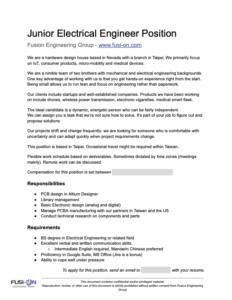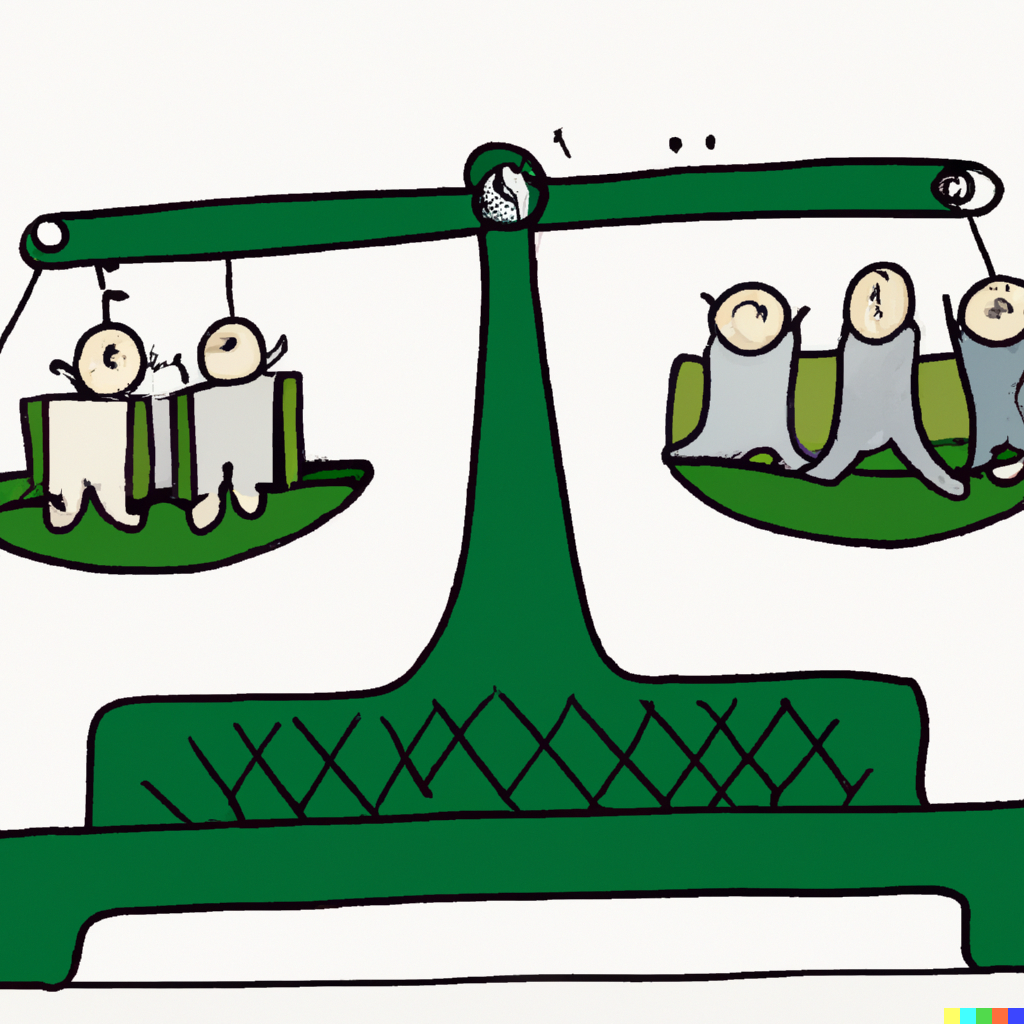In the realm of small business ownership, every new hire is a pivotal decision. When you’ve got a small team, every new hire has the potential to impact the dynamic for better or worse.
This blog post is a guide on ensuring your hiring elevates your company rather than dragging it down.
We’ve aimed this post specifically at what we know best – small engineering firms. That’s because we know the hiring strategy is different when you’ve got 500 employees vs. 3 – because we’ve done both.
We’ve got 5 years of experience managing a dynamic team of projects in all sorts of industries, and we’re ready to share what we’ve learned.
Table of Contents:
- Finding someone
- Interviewing
- Onboarding
Finding someone – who are you trying to hire?
When it comes to hiring, defining your needs and objectives is the first crucial step. Before crafting a job description, you need to be sure about what you want. This is different for every company and situation, but the steps below are designed to prompt thinking in what we think are the key areas.
Specific needs, specific skills.
Without understanding what need is being filled by this new hire, it is impossible to determine the right candidate. Clarity around roles and responsibilities starts with you, the employer.
Things to consider:
- What specific jobs will this hire be responsible for?
- Skills are required for those jobs?
- Hard
- Soft
For example – if you’re hiring for a front-facing job, communication skills will be hugely important. In a role where the candidate would deal with clients and key stakeholders, their communication and presentation skills directly reflect your company.
Contrastingly, if the need you have is purely technical (say, assistance with PCB board design), there’s almost no requirement for external communication skills, but the candidate’s PCB design skills are paramount.
How urgent is your need?
The urgency of the company’s needs will inform your candidate selection.
If the needs are not immediate but anticipated as a result of growth, you can likely afford to take a longer time horizon into account. This is an example where a more junior hire might work best, as you’ve got the time and resources to train and get them perfectly integrated into the team. It’s an investment, but it’s worth it if you’ve got the time to realize the gains.
On the other hand, in a situation where you urgently need specific skills – for example, you’ve taken on a project that requires x specific technical skill, you don’t have that luxury. You need to find a senior candidate with the required skills and get them working fast.
The size/stage of your company will also influence your thinking here. If you’re a small, 2 man band, there might be more pressing needs. Business management skills? Marketing? On the other hand, being small means you’ve got the opportunity to grow with your employees. This is a fantastic chance for your company to flourish alongside its workers. In our experience, this investment in people is what builds truly strong companies.
Company fit – fill the gaps
Lastly, take some time to consider fit. In our experience, people spend too much time thinking of technical abilities and not enough time considering fit. Fit extends beyond a resume’s qualifications or a candidate’s technical skills. Instead, it revolves around a more profound question: what kind of people thrive in your work environment? Moreover, what sort of people is your work environment missing?
This is especially important in smaller companies, where one new hire has more potential impact on your team dynamics. Instead of thinking of this as a risk, view it as an opportunity – you’ve got a chance to really improve on the aspects of your team that are lacking.
A helpful way to start understanding what your team needs is doing a “gap analysis.”
Every team has its unique cognitive landscape, with each member contributing distinct thinking patterns and strengths. Consider if there are any missing pieces in your team’s collective thought process. Perhaps you need:
- Someone adept at generating ideas on the fly.
- A detail-oriented individual who ensures no stone is left unturned.
- A cultural ambassador who embodies and promotes the company’s values, ensuring a sense of identity and purpose.
- A negotiator or conflict resolution expert.
- A team player and collaborator:
There are, of course, many more to consider. Each team dynamic is vastly different, and it is impossible to break it down into components like this. Take the time, consider yours. It will make the following steps of this post much simpler.
The job description
Now that we’ve got a good understanding of what we want out of this new hire, we can start building the job description. If you’ve taken proper care and spent some time considering and thinking about the items above, this bit should be easy.
From the perspective of the new hire, the job description is critical. It allows a good understanding of what is expected from both parties and a starting point for success for the starter.
One thing to remember is to make a distinction between nice-to-have aspects and must-have aspects for your candidate. For example, we identified in our internal discussions that it would be great if our candidate had communication proficiency in Chinese – we ended up deciding that this is a nice-to-have skill rather than a must-have.

The interview
Nice work! You’ve found a candidate to interview for the position. Now, find another…
We would recommend interviewing at least (3)? Candidates for one position. This way, you can understand the strengths and weaknesses of each, helping you appreciate the one you go with more. It’s also a great chance to practice your interviewing skills.
As every company requirement, candidate, and interview is different, we won’t outline specific questions for you to ask. Instead, this section provokes thought about the objective of the question itself. From there, we can work backward and build a question that targets what we want to understand about the candidate.
This section is broken down into 3 sections that map well to the thinking we did above.
- Cultural questions – the who
- Technical questions – the what
- Situational questions – the how

Our cultural questions assess who the candidate is.
Our technical questions assess what the candidate knows.
Our situational questions assess how the candidate works, learns, and thinks. We’ve put this section in the middle of the Venn diagram above because in many ways it’s the “glue” or the intersection of everything else.
We’ve also provided some example questions in each section, but we stress the importance of developing new questions yourself. The questions in each section should be treated as an example of how we think about our questions. When coming up with your own questions, treat each question as a tool to deepen your understanding of the candidate. Think first about what you want to understand about them, and then form a question around that.
An excellent way to approach this would be to consider the answers you gave to the prompts in the previous section and form questions to gain deeper insight into specific aspects of those answers – if you wanted a strong communicator who could deal well under pressure, use questions to put them on the spot and test their ability to communicate effectively. Contrastingly, if you’re after a hyper-technical PCB designer, use your questions to dig into the depth of their understanding.
Lastly, it’s important to note the following: Sometimes, the way the candidate reacts to the question is just as important as their final answer.
If you ask them a technical question they don’t know the answer to, don’t write them off on the spot. It’s an excellent opportunity to see how they handle an unfamiliar situation. Do they get overwhelmed and shut down? Do they make something up? Or do they handle it with grace and confidence, answering the question to the best of their ability without fabricating an answer? Often, their behavior in these situations is more important than their existing knowledge base.
Cultural – the who:

We recommend starting here as it’s a great way to ease into the interview process. Here, you should explore the candidate’s values, work style, and compatibility with the company culture. This is about assessing who the candidate is.
The thinking you did in section 1 about the sort of person your company needs right now will make these questions simple but not easy.
How can you ask a question to determine whether this candidate fills your identified gap?
Examples:
- Tell me about a time when you had to collaborate with a diverse group of individuals. How did you ensure effective communication and mutual understanding among team members?
- What do you do outside of work?
- “How do you typically handle feedback and criticism?”
- Describe a work environment or company culture where you felt most productive and comfortable. What aspects of that environment were particularly appealing to you?
- Describe a situation where you had to prioritize competing tasks or projects. How did you decide which ones were most important?
- Can you give an example of a time when you took the initiative to improve a process or situation in your previous workplace? What was the outcome?
- How do you approach work-life balance? Can you share an example of how you’ve managed your time and responsibilities to maintain a healthy balance?
- What role do you believe company culture plays in driving business success? Can you give an example of how a positive or negative culture impacted a company you’ve worked for?
- Describe a time when you had a disagreement with a colleague or supervisor about a work-related issue. How did you approach the situation to find a resolution?
Technical – the what:

We’d encourage you to think about technical ability last. While obviously important, fit and propensity to learn are much more important to us. If the candidate has limited experience in a technical field but has shown capability and interest in picking up new skills, we get excited.
Obviously, the technical questions you ask are hyper-dependent on the industry, skills, and company needs. Our engineering firm does primarily electrical and mechanical engineering work, so we’ve provided examples that work for us. We’ve also kept the examples here to brief skills for the same reason.
Mechanical Engineering questions:
- CAD software experience
- PLM and PDM tools experience
- DFM, DFA experience
- Materials knowledge (metallurgy, plastics, composites)
- Quality Control, FAI, SOPs
- Manufacturing (machining, 3D printing, sheet metal, injection molding, casting)
Electrical Engineering questions:
- CAD software experience
- Comm buses experience
- Digital electronics experience
- Analog electronics
- Sensors
- USB protocols
- Software development experience
- High-speed signal routing
- General PCB layout guidelines
- RF theory
- Types of antennas and when to use them
- PCB impedance control
- UART, serial interfaces
Situational – the how:
Here, there will be a lot of variation depending on your company’s needs.
We like to think of these types of questions as the bits between the who and the what. You’re trying to get a feel for how the candidate thinks.
That’s easier said than done, but here’s a few strategies that have worked for us in the past:
- Make them make an estimate something. For example, how many credit cards do you think there are in the United States? Here, the final answer isn’t that important (to an extent). We’re more focused on their assumptions and their justifications for those assumptions.
- What have you changed your mind on recently, and why?
Another excellent strategy for understanding someone’s mind is…
Let them ask questions
It’s essential to let the candidate ask some questions, too. But don’t tune out – the interview isn’t over yet.
This is an incredible opportunity to asses how the applicant approaches learning about something new, their ability to prepare ahead of time, etc.
An applicant who asks no questions probably isn’t someone you want on your team.
Integration/onboarding
Congrats, you’ve made a new hire. What next…
Protect your company.
- Contract
- Sending the offer
- Code of conduct.
For each of the above steps, we recommend seeking legal help. It’s a safer alternative and makes protecting your company a priority – as it should be.
Integration
The better your job description, the easier this phase will be. The onboarding employee will better understand your expectations and vice versa.
Having said that, a robust onboarding process can be executed mainly by the newly hired person, saving you a lot of time.
Here are some starting points to make this process seamless in your company:
- Have an archive of training videos. They go a long way as they can be used to practice on mock/straightforward projects, and the newly hired can shape their workflow to what is proven to be the most efficient way.
- Have your new employee write down comments, questions, and thoughts about the training material.
- Host 1-on-1 weekly/bi-weekly sessions. On a regular basis, have a meeting with your new employee to hear your feedback about any aspect of his/her experience so far. This could be interpersonal relationships with colleagues, difficulties, or suggestions for improvement.
- Together with your new employee, review the feedback he/she has on your training docs.
You’re done!
Hiring in small businesses is a big deal. A new team member can really change how things work. This guide is here to help your hires make your company better, not worse.
We’re focusing on small engineering firms because we’ve been there, managing projects in different industries for five years. We want to share what we’ve learned.
Every step matters, from figuring out what you need to write the job ad to interviews and settling in the new hire. It’s not just about skills; it’s about finding the right fit for your team.
Investing time in finding the right person pays off. Remember, a good hire helps your company grow. So take your time and make it count.

